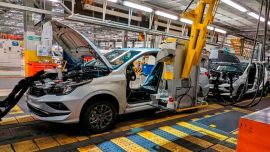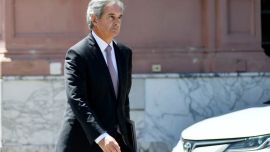With the “blue” greenback hitting record levels for this year at least in a country sinking ever deeper into the red (with every chance of soon eclipsing last spring’s all-time peaks), it might surprise some readers to learn that once upon a time Argentina’s currency could look down on the almighty dollar along with pound sterling and very few other coinages in a pre-euro world – and yet incredibly enough, back in mid-1985 you did not even need all of a newly-minted austral to purchase one whole banknote bearing George Washington’s portrait (just 80 cents sufficed). It might also surprise many readers to learn that there were ever times when Argentina’s currency was not called what is fast becoming a four-letter word – namely, peso – but the austral was this country’s official denomination for 70 months between 1985 and 1991. All the work of the former economy minister Juan Vital Sourrouille, who would have turned 81 next month but died last Wednesday.
Sourrouille died almost forgotten but within my lifetime (which began on today’s date in mid-century) only two of the 58 ministers in that period have ridden the tiger of Argentina’s volatile economy for longer than his 1,501 days – José Alfredo Martínez de Hoz (1,828 days) and Domingo Cavallo (2,261 days) since the Peronist Ramón Cereijo (1946-1952). Like few other political figures that ministry consumes his biography almost entirely with little remarkable to record either before or since. Except perhaps for his nickname “Quatrocchi” (four eyes) conferred on him very early in life by his schoolmates due to his pebble glasses – this conveys his cerebral image as well as anything. Dedicating his whole life to the dismal science after graduating as an accountant, Sourrouille was an economist pure and simple with none of the usual prefixes, whether “orthodox” or its opposites.
So let us now dissect that ministerial career. Planning secretary at the Economy Ministry between late 1983 and early 1985 under the Radical presidency of Raúl Alfonsín, Sourrouille jumped to the top of the portfolio on February 19, 1985. Alfonsín’s first minister Bernardo Grinspun had come to grief from failing to place negotiations with the International Monetary Fund on track amidst nagging inflation with midterm elections looming later that year. Does any of that sound familiar today?
Then as now inflation was the root of most problems. The 1980-1982 financial crisis eventually bottomed out into a curious twilight zone which was neither monetary stability nor runaway hyperinflation – instead a high and heavily index-linked inflationary plateau with the cost of living clocking in at around 25 percent month in, month out throughout 1983 and 1984. But in early 1985 the monthly inflation index accelerated to levels more like 30 percent and threatened to move beyond with hyperinflation hitting various countries worldwide in that period ranging from Bolivia to Israel (the fastest inflation in Latin American history in the former case with annual rates of up to 60,000 percent). Clearly Sourrouille had to move fast.
But the hitherto planning secretary had been planning a few things in the preceding months and within a dozen weeks the Austral Plan was all ready for President Alfonsín to announce. It was a shock package whose basic elements were a total wage and price freeze, the elimination of all index-linking (extended to the exchange and interest rates) and a halt to all money-printing with the dose of fiscal austerity needed to make that realistic – inflation plunged from 30 to six percent in the first month of the new austral currency.
The November midterms that year were a resounding triumph for Alfonsín against a Peronism split between traditional and Renewal sectors – the Radicals took 43 percent of the vote, only garnering less Congress seats than the opposition in three provinces (six others were tied). It remains debatable whether all the credit for this success should go to the humble nerd Quatrocchi. The junta trials were then five weeks away from their final verdict and much of the citizenry considered it vital to buttress the new democratic government against a still very real military threat (which was to materialise at least four times in the next five years) – Alfonsín played to that mentality for all its worth with his absurd state of siege in October (the dozen “anti-democratic conspirators” denounced then included the highly respected pundit Rosendo Fraga who has done nothing in the following 35 years to justify that smear). But there can be little doubt that with monthly inflation of 30 percent and beyond the Radicals would have crashed to a humiliating defeat.
As they did at the next midterms in 1987 (“What does UCR stand for? Unicamente Córdoba y Ríonegro” was the political joke that year since they only won in those two provinces). Capitulation to military pressure in the form of the 1986-1987 amnesty legislation might well have been a major factor too but meanwhile the wheels had come off the Austral Plan. Low global commodity prices conspired against a sufficient inflow of dollars to defend the higher level of the austral and boost reserves while Argentina’s notorious trade unions (as reflected by the 13 general strikes called by then-CGT secretary-general Saúl Ubaldini) soon started feeding wage-push inflation into the equation with the pioneering privatisation efforts of public works minister Rodolfo Terragno obstructed by Peronism (only to be adopted a couple of years later by the Peronist Carlos Menem).
Sourrouille’s acquired prestige was strong enough to survive the midterm setback and retain Alfonsín’s loyalty but the 1989 Radical presidential candidate Eduardo Angeloz insisted on the removal of both the minister and his Austral Plan, replacing it with his own somewhat amorphous Spring Plan based on deregulation and privatisation (also to be adopted by Menem). The only result was to see a monthly inflation of 19 percent in the last month of Sourrouille (March, 1989) soar to 80 percent just two months later and 197 percent two months after that as hyperinflation rocked the country.
The successive fates of the austral and convertibility would suggest that Argentina’s currency is like Icarus – the closer it flies to the sun, the harder the economy crashes since inaugurating an exchange rate superior to the greenback and pegging the peso to the dollar respectively ended in the 1989 hyperinflation and the 2001-2002 meltdown. These pandemic times differ sharply from 1985 – currency options now include bitcoin and the barter culture of the 2001-2002 meltdown has seeped into the monetary sphere with the Senebi dollar, among other novelties – but a deeper study of the austral experiment would still seem especially timely in the hour of its mastermind’s death.



















Comments